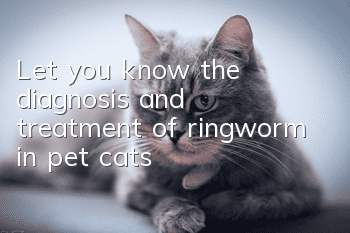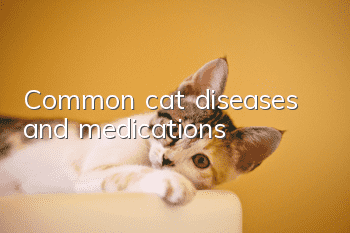Let you know the diagnosis and treatment of ringworm in pet cats!

Take you to understand the diagnosis and treatment of pet cat ringworm! Feline ringworm, commonly known as ringworm or ringworm, is a common skin disease in cats caused by Microsporum canis infection in cats. It is a zoonosis. Prevention and treatment of this disease The disease has certain significance to public health security. The disease generally presents chronic symptoms in cats. Although cat ringworm itself will not cause the death of the cat, the cat will suffer from severe bacterial infection due to the reduced resistance of the skin, leading to a series of complications such as sepsis and bacteremia. In severe cases, the disease will cause chronic symptoms in cats. Can cause death of animals. I have some experience in treating cat ringworm and have achieved relatively satisfactory results. I will now share my diagnosis and treatment situation and experience with all netizens.
1. Transmission route
The transmission route of cat ringworm is contact infection, that is, the disease can be transmitted to the healthy through anything that the sick cat comes into contact with. cats, dogs and humans. Because cats have a large range of movement, the spread of the disease is very difficult to control, especially when feral cats become infected.
2. Main clinical symptoms
Usually, cats with cat ringworm have no particularly obvious symptoms at the beginning of the disease, and become mentally ill after a period of time. If the disease is not good, the body will become thinner if the disease course is longer, the hair will be dull, and the hair will fall off partially or in large areas. Ringworm is more common on the trunk, and a few cases can also be seen on the head, limbs, ears and tail. The affected area is itchy, varying in severity, and some cats develop secondary bacterial infection due to scratching. Typical symptoms are hair loss on the skin of the affected area, and the appearance of annular scaly, dry round macules; some affected areas still have some hair roots remaining, some affected areas are completely hairless, and some affected areas have hair growing in the middle of the ringworm spots. Some cats need to be carefully stroked with their hands to find out because the cat owners sent them to the doctor early. Small protrusions can be felt when touched by the hand, and there are small scabs and dander under the coat.
3. Diagnostic methods of cat ringworm
1. In a relatively dim environment, use a Wood's lamp to illuminate the affected area of the cat's skin. Hairy roots with yellow-green fluorescence. Note that it is different from the green fluorescence that appears in some ointments.
2. Scrape the coat or dander from the edge of the affected skin on a glass slide, add a few drops of 10% potassium hydroxide solution, heat it slightly with an alcohol lamp, cover it with a cover slip, and examine it under a microscope Observation reveals fungal spores.
4. Treatment of cat ringworm
Use a combination of topical medication and oral antibiotics. It is not easy to cure with external drugs alone, and oral antibacterial drugs are required.
1. Zhentaishu Spray: A drug for fungal skin diseases in dogs and cats. It is very effective in both treatment and prevention.
2. Clotrimazole ointment: This medicine is non-irritating and has good curative effect. It usually takes about two weeks of treatment to cure.
3. Ketoconazole ointment: a broad-spectrum antifungal drug that can be used by both humans and animals to treat ringworm and should be used for 2 to 8 weeks.
5. Others
1. If possible, you can have a period of sunshine every day, but you should be careful to prevent heatstroke and sunburn.
2. Dissolve sulfur soap in water and give the cat a bath for about fifteen minutes each time. Pay attention to contact with as much water as possible. After washing, try to dry the coat and blow dry it. 2 times a week.
3. Because cat ringworm can be transmitted to humans, attention should be paid to disinfection. Try to choose a disinfectant with a lighter smell, use pet-specific disinfectant or other disinfectants, but pay attention to the dilution ratio. Because cat ringworm is spread through spores, disinfecting the environment is important. At the same time, the living environment of affected cats should be kept dry and ventilated. Fibers, woolen fabrics, clothing, etc. that have been in contact with infected cats should be boiled and disinfected by exposure to the sun. Utensils used by infected cats should be sprayed with disinfectant diluted as required every day, and furniture and floors within the range of their activities should be wiped with diluted disinfectant every 2 days to effectively prevent the spread of cat ringworm.
4. Give the affected cat an animal vitamin supplement for half a year to enhance its physical fitness.
5. The affected cat should be kept in isolation and restricted in its range of activities, especially at night.
VI. Thoughts and understanding
1. Cat ringworm can occur all year round, but the incidence rate is high in hot and humid summers. Cats that live in a humid environment, are malnourished, and are weak and sick are more susceptible to infection and have a longer recovery time. Increasing the intake of nutrients, especially B vitamins, is beneficial to preventing the occurrence of the disease and is also conducive to the recovery of affected cats.
2. Cat ringworm requires laboratory diagnosis. Inexperienced people can easily misdiagnose it as acariasis using the naked eye.
3. If the cat scratches a lot, be careful to wear an Elizabethan ring, because when the cat scratches the affected area, it may cause secondary bacterial infection, leading to severe exudative inflammation. Redness, swelling and erosion of the affected skin area can be seen, and in severe cases It can suppurate, so attention should be paid to the treatment and care of inflammation.
4. The treatment of cat ringworm takes a long time, and medical staff and cat owners need to be patient. As long as they persist in treatment and take proper care, they can generally be cured. Since cured cats have a certain degree of immunity (mainly cellular immunity) within a certain period of time, the author has not yet seen a case of recurrence after complete cure.
5. The development of cat ringworm generally spreads from the center of the affected area to the surrounding areas in a circular pattern. Improper treatment and care will prolong the treatment time and even cause recurrence. This situation includes wrong medication or dosage, incorrect topical treatment, not shaving hair, intermittent treatment, failure to administer medication at the prescribed time, and failure to use the same medicine. Treat all animals in the house or in frequent contact together, and do not pay attention to the cleaning and disinfection of the environment and equipment.
6. Veterinarians and pet owners should carefully clean and disinfect the parts and clothing that have come into contact with infected cats in a timely manner to prevent the spread of fungi. In addition, oral multivitamins should be taken appropriately to enhance physical fitness and prevent infection.
- Why does the kitten vomit milk?
- How to brush your cat’s teeth to prevent dental disease?
- Is mint harmful to cats?
- Is it feline plague if a cat only drinks water but doesn’t eat?
- Are most white cats with blue eyes deaf?
- What should I do if my cat doesn’t sleep in the nest?
- Cat suddenly vomits undigested cat food
- How long does a 3-month-old kitten sleep a day?
- Can cats eat walnuts?
- Why does a cat meow at night instead of meowing during the day?



